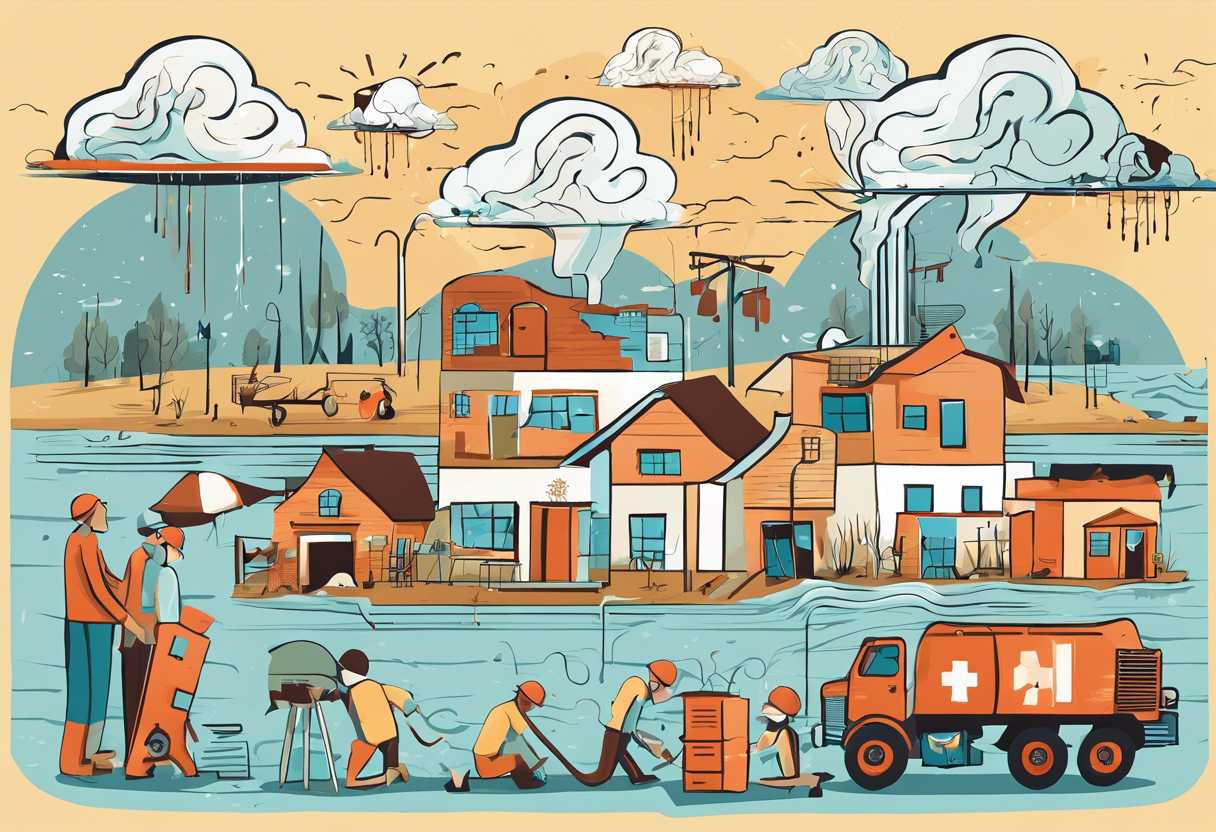Disasters and disaster risk are two interconnected yet distinct concepts that play a crucial role in shaping the safety and well-being of communities and individuals. Understanding the differences between these two terms is essential for effective disaster management and risk reduction strategies. In this blog post, we will delve into the concept of disasters and disaster risk, identifying their causes and impacts, evaluating the factors that contribute to disaster risk, and exploring ways to mitigate and manage disasters through risk reduction strategies. Additionally, we will discuss the importance of building resilience and preparedness for disasters and disaster risk. By the end of this post, you will have a comprehensive understanding of the complexities surrounding disasters and disaster risk, and the necessary steps to address them effectively.
Understanding the Concept of Disasters and Disaster Risk
The Definition of Disasters
Disasters are events that cause significant disruption, destruction, and distress to a community or society. These events can be natural, such as earthquakes, hurricanes, and floods, or human-made, such as industrial accidents or terrorist attacks. Disasters can result in loss of life, injury, and damage to infrastructure, property, and the environment. Understanding the concept of disasters involves recognizing the potential impact they can have on individuals, communities, and the economy.
Disaster Risk and Vulnerability
Disaster risk refers to the potential for loss and damage from a disaster event. It encompasses the likelihood of a disaster occurring and the severity of its impact. Vulnerability, on the other hand, refers to the susceptibility of a community or society to the effects of a disaster. Factors such as poverty, inadequate infrastructure, and lack of access to resources can increase vulnerability to disasters. Understanding disaster risk and vulnerability is crucial for developing effective strategies for disaster preparedness, response, and recovery.
Measuring and Mitigating Disaster Risk
Measuring disaster risk involves assessing the likelihood and potential impact of various disaster events. This can be done through risk modeling, which uses data on hazards, exposure, and vulnerability to estimate the potential consequences of a disaster. Mitigating disaster risk involves implementing measures to reduce the likelihood and impact of disasters. This can include improving building codes, implementing early warning systems, and promoting community preparedness. By understanding and addressing disaster risk, communities can become more resilient and better able to withstand and recover from disaster events.

Identifying the Causes and Impacts of Disasters
The Root Causes of Disasters
Disasters can be caused by a variety of factors, including natural phenomena such as earthquakes, hurricanes, and floods, as well as human activities like industrial accidents, deforestation, and urbanization. Understanding the root causes of disasters is crucial in developing effective prevention and mitigation strategies. *Environmental degradation, climate change, and inadequate infrastructure are often contributing factors to the occurrence and severity of disasters.*
The Impacts of Disasters
Disasters can have far-reaching impacts on communities, economies, and the environment. They can result in loss of life, displacement of populations, destruction of infrastructure, and disruption of essential services. *The economic impacts of disasters can be significant, leading to loss of livelihoods, increased poverty, and strain on government resources.* Additionally, disasters can have long-term effects on the environment, including soil erosion, water contamination, and loss of biodiversity.
Prevention and Mitigation Strategies
Effective prevention and mitigation strategies are essential in reducing the risk and impact of disasters. This can include measures such as early warning systems, land-use planning, building codes, and disaster preparedness training. *Investing in resilient infrastructure and promoting sustainable development practices can also help to minimize the vulnerability of communities to disasters.* By identifying and addressing the root causes of disasters, and implementing proactive measures, it is possible to build more resilient and disaster-resistant societies.

Evaluating the Factors that Contribute to Disaster Risk
Geographical Location
One of the primary factors that contribute to disaster risk is the geographical location of an area. Regions that are prone to natural disasters such as earthquakes, hurricanes, or floods are at a higher risk compared to areas with a lower frequency of such events. For example, coastal areas are more susceptible to hurricanes and tsunamis, while regions near fault lines are at a higher risk of earthquakes. Understanding the geographical location and the potential natural disasters that can occur is crucial in evaluating disaster risk.
Population Density
Population density plays a significant role in determining disaster risk. Areas with high population density are more vulnerable to the impact of disasters due to the concentration of people and infrastructure. In the event of a disaster, the potential for casualties and damage to property is higher in densely populated areas. Additionally, the strain on resources and emergency services can be more significant in densely populated regions, affecting the overall response and recovery efforts. Evaluating the population density of an area is essential in understanding the potential impact of disasters.
Infrastructure and Building Standards
The quality of infrastructure and building standards directly influences disaster risk. Areas with outdated or poorly constructed infrastructure are at a higher risk of damage and collapse during disasters such as earthquakes or hurricanes. Similarly, regions with inadequate building codes and standards are more susceptible to structural damage and casualties. Evaluating the infrastructure and building standards of an area, including the resilience of critical facilities such as hospitals and emergency shelters, is crucial in assessing disaster risk.
Mitigating and Managing Disasters through Risk Reduction Strategies
The Importance of Risk Reduction Strategies
Risk reduction strategies play a crucial role in mitigating and managing disasters. By identifying potential risks and implementing measures to reduce their impact, organizations and communities can minimize the damage caused by natural or man-made disasters. These strategies not only save lives but also protect infrastructure and resources, ultimately leading to a more resilient and sustainable society.
Key Components of Effective Risk Reduction Strategies
Effective risk reduction strategies involve a combination of proactive measures aimed at preventing disasters and reactive measures to minimize their impact. This includes conducting thorough risk assessments, implementing early warning systems, developing emergency response plans, and investing in resilient infrastructure. Additionally, community engagement and capacity building are essential for ensuring the successful implementation of these strategies.
- Thorough risk assessments
- Early warning systems
- Emergency response plans
- Resilient infrastructure
- Community engagement and capacity building
Examples of Successful Risk Reduction Strategies
Several countries and organizations have successfully implemented risk reduction strategies to mitigate the impact of disasters. For example, Japan’s strict building codes and early warning systems have significantly reduced the impact of earthquakes and tsunamis. Similarly, the Netherlands’ extensive flood protection measures have effectively minimized the risk of flooding. By studying these successful examples, other regions can learn valuable lessons and tailor their risk reduction strategies to their specific needs and challenges.
Building Resilience and Preparedness for Disasters and Disaster Risk
The Importance of Disaster Preparedness
Disasters can strike at any time, and being prepared can make all the difference in minimizing their impact. Whether it’s a natural disaster like a hurricane or earthquake, or a man-made disaster such as a terrorist attack, having a plan in place can save lives and reduce damage. *Building resilience and preparedness for disasters is crucial for individuals, communities, and organizations.*
Key Steps for Disaster Preparedness
There are several key steps that can be taken to build resilience and preparedness for disasters. First and foremost, it’s important to *create a comprehensive emergency plan* that outlines what to do in the event of various types of disasters. This plan should include evacuation routes, emergency contacts, and a designated meeting place. Additionally, it’s essential to *assemble an emergency kit* that includes food, water, first aid supplies, and other essentials. *Regular training and drills* can also help ensure that everyone knows what to do in an emergency.
Disaster Risk Reduction Strategies
Implementing disaster risk reduction strategies is essential for minimizing the impact of disasters. This can include *investing in infrastructure improvements* such as flood barriers and earthquake-resistant buildings. *Early warning systems* can also help to alert people to potential disasters, giving them time to take action. *Community engagement and education* are also important, as they can help to raise awareness and build resilience at the local level.
Conclusion
In conclusion, it is crucial to understand the differences between disasters and disaster risk in order to effectively mitigate and manage their impacts. By identifying the causes and impacts of disasters, evaluating the factors that contribute to disaster risk, and implementing risk reduction strategies, we can work towards building resilience and preparedness for potential disasters.
It is important for individuals, communities, and governments to prioritize disaster risk reduction efforts in order to minimize the devastating effects of disasters. By taking proactive measures and investing in sustainable solutions, we can create safer and more resilient environments for future generations.
Ultimately, by increasing awareness and understanding of the complexities of disasters and disaster risk, we can work towards creating a more secure and sustainable future for all. Let’s continue to educate ourselves and others on the importance of disaster risk reduction and take action to build a more resilient world.

